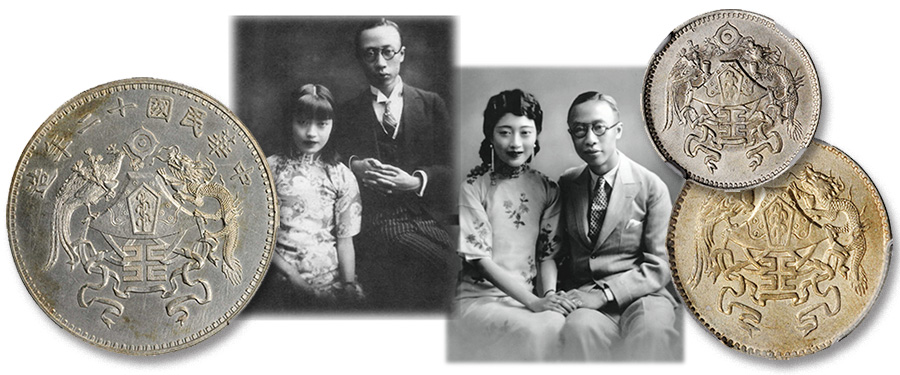
The downfall of the Qing dynasty and the beginnings of the Republic was a period of great flux in China, during which infighting within the royal house played a large role. The penultimate monarch, the Guangxu Emperor, was at odds with the Empress Dowager, Cixi, with the former passing away just one day before the latter. In an eventful period in November 1908, she selected who would become the final Qing emperor—a boy not even three years of age. Born in 1906 to Zaifeng, the Prince Chun, Puyi was a nephew to his predecessor, the Guangxu Emperor, and never had the chance to rule in his own right given his age. For the majority of his brief reign, Puyi’s father served as regent, a task for which he was completely inexperienced as China emerged in the 20th century. Revolutionaries continued their push for a new China, with Zaifeng leaving his role as regent in late 1911, replaced by the Guangxu Emperor’s widow, the Empress Dowager Longyu. It quickly became apparent to Longyu that the dynasty was impossible to preserve, and she signed the "Articles of Favorable Treatment of the Great Qing Emperor after His Abdication," creating a transition for China and a new role for the boy-emperor. Among these treatments were the retention of his title of dignity, an annual subsidy from the new Chinese government, and other privileges consistent with his former status.
By 1922, the elder women in Puyi’s life decided that it was time for the abdicated monarch to take a wife, as he had attained the age of 16. Presented with a selection of images of aristocratic teenage girls from which to choose, Puyi eventually arrived upon Gobulo Wanrong—the daughter of one of the richest aristocrats in Manchuria. Despite the fact that he was a decade removed from serving as emperor, he was still allowed a rather magnificent ceremony rivalling that which he would have experienced were he still emperor in his own right. Before the wedding, Wanrong was carried on a sedan chair called the "Phoenix Chair" to the Forbidden City, where she met her future husband for the first time, Puyi being seated in the "Dragon Throne." In addition to the traditional mask, Wanrong wore a satin cloth adorned with the "dragon and phoenix" iconography, further reinforcing this ancient symbolism. For the remaining 24 years of her life, she remained the consort of Puyi, serving as the Empress consort of Manchukuo during Puyi’s WWII-era reign of the Japanese puppet state. Following World War II and the Second Sino-Japanese War, she was captured by Chinese Communist forces, and died in prison in 1946. Puyi himself would be imprisoned as a war criminal in 1949 for a period of 10 years for his role in the now-defunct puppet state, succumbing to multiple ailments in 1967 at the age of 61.
Returning to the "dragon and phoenix" iconography, the issuance of a pattern dollar in 1923 and its 20 and 10 cent minors in 1926 presents these ancient symbols supporting "twelve ornaments" in what can be described as a modern coat-of-arms for the still newly established nation. In his opus on Chinese numismatics, Eduard Kann proposed that this brief "dragon and phoenix" coin series was issued in honor of the former emperor’s wedding from the previous year, 1922. As such, the "Pu Yi Wedding type" became synonymous with the three denominations. This attribution, however, is now known to have been erroneously applied by Kann, and the overall type is seen merely as a glimpse into the proposals for a new national emblem. Nevertheless, the series evokes the idea of a fanciful royal wedding, alluding to the male and female roles of the dragon and phoenix throughout Chinese culture and serving as a bridge to the modern revival of the iconography with more recent bullion issues.
Our Official Auction of the Hong Kong Show in May will present numerous examples of the 20 and 10 cent denomination, as well as an incredibly rare and attractive pattern dollar—a rather brilliant and mostly untoned PCGS MS-64—presenting an excellent opportunity to acquire one of these touchstones to a pivotal period and person in the modern history of China.
To view our upcoming auction schedule and future offerings, please visit StacksBowers.com where you may register and participate in this and other forthcoming sales.
We are always seeking coins, medals, and pieces of paper money for our future sales, and are currently accepting submissions (until May 4th) for our upcoming CCO (Collectors Choice Online) auction in June 2020. Following that, our next larger format sales will be our Official Auction of the ANA World’s Fair of Money and our Official Auction of the Hong Kong Show, both in August 2020! If you would like to learn more about consigning, whether a singular item or an entire collection, please contact one of our consignment directors today and we will assist you in achieving the best possible return on your material.





